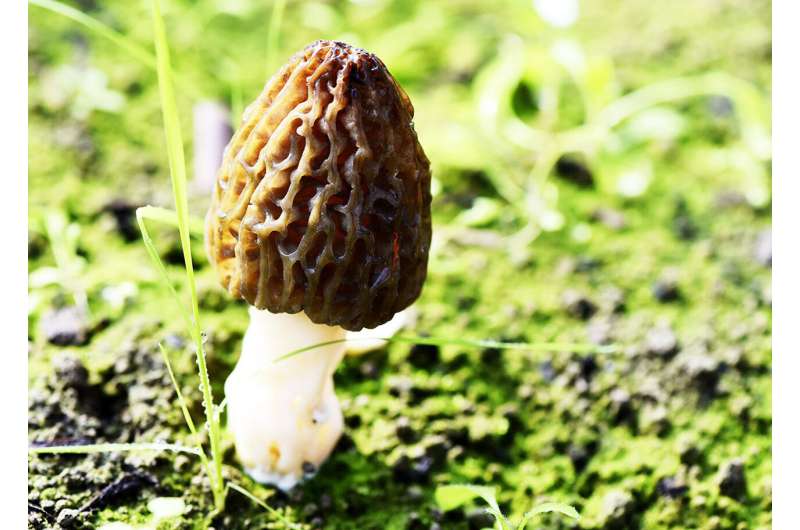Triggering morel fruiting

Morels are economically, culturally, and ecologically important fungi, widely prized as a culinary delicacy, but also because they influence geochemical cycling in forest ecosystems. By deciphering the fruiting-related decomposition mechanisms of morel with multi-omic approaches, the results revealed a striking capability of morel mycelium to acquire carbon from lignocellulosic-abundant matters such as plant litter and to incorporate the assimilated carbon into the soil, reducing the amount of CO2 emissions from decaying leaves and woods into the atmosphere, while increasing the organic matter and fertility of the soil.
Morels (Morchella spp.) were previously considered uncultivable wild mushrooms, until Ronald D. Ower, a researcher from San Francisco State University, developed a technique to successfully obtain fruiting bodies of morel in walk-in growth chambers in 1980s. Unfortunately, he died suddenly, and his patent has proven difficult to reproduce. While scientists and biotechnological engineers all over the world continued to seek other ways to make morels fruit under artificial environments, a technique to supply exogenous nutrients was developed.
The exogenous nutrient bag (ENB) allowed black morels (e.g., M. importuna Kuo, O'Donnell & Volk) to successfully fruit in common farmland soils. Compared to the contingent fruiting in the wild, this technique provides a highly reproducible system which allows the black morel to complete its lifecycle in an artificial environment. It is particularly helpful for studying physiological and biochemical processes driving the fruiting of soil saprotrophic mushrooms. To date, how the nutritional acquisition of the morel mycelium is fulfilled by the exogenous nutrient supply to trigger its fruiting remains unknown.
To interpret the mechanisms fulfilling nutritional demands and triggering fruiting in morel, a cultivable black morel strain M. importuna SCYDJ1-A1 from Sichuan Province, China, and a wild black morel strain M. importuna CCBAS932 from the forests of France, were sequenced and annotated by a collaborative team. The genome sequences and annotations are available on JGI's fungal portal MycoCosm. Based on these analyses, the researchers conducted further field experiments to determine the biochemical processes taking place during the lignocellulose decomposition by the black morel, as well as the gene-expression programs encoding the biochemical processes unveiled by transcriptomics and proteomics.
The key findings contribute to an increasingly detailed portrait of molecular features triggering morel fruiting. They include:
- A diverse set of hydrolytic and redox CAZymes secreted by the morel mycelium drives ENB substrate decomposition. Meanwhile, hints of potential assistance from co-habitant microorganisms were unmasked.
- Plant polysaccharides such as starch and cellulose were rapidly degraded by a set of significantly upregulated glycoside hydrolases, while triglycerides were accumulated initially by the morel mycelium and consumed later.
- The above-mentioned decomposition leads to sustained exportation of organic carbon nutrients into the surface soil adjacent from the exogenous nutrient supply, resulting in a rapid increase of the organic carbon content in the soil, which was thereafter consumed during morel fruiting.
- The above observation revealed a high capability of morel to mobilize organic carbon from lignocellulosic-abundant matters such as fallen leaves and woods above forest soils. This is important to decrease CO2 emissions from decaying leaves and woods into the atmosphere, as well as increase the organic matter and fertility of the soil. More importantly, this mechanism can keep the forests from over-accumulation of plant litter, which could cause forest fires.
- Compared to the high consumption and acquisition of carbon, nitrogen was not substantially exported from the exogenous nutrient supply to the soil. In contrast, isotopic evidence showed that morel mycelium colonizing the lignocellulosic-abundant exogenous nutrient source had to borrow some nitrogen from the soil to manufacture catabolic enzymes for the decay apparatus. Consequently, it created a subtle flow of nitrogen from the soil towards the exogenous nutrient source.
- The opposite directions of carbon and nitrogen mobilizations not only mimic the decomposition of plant litter layer above forest soils, but the nutritional association between mycorrhizal fungi and tree roots as well. This might be one of the key physiological factors that trigger forest mushrooms with diverse trophic modes to convert from vegetative mycelium growth to sexual processes including mating and fruiting, which is worth further investigation.
More information: Hao Tan et al. Multi‐omic analyses of exogenous nutrient bag decomposition by the black morel Morchella importuna reveal sustained carbon acquisition and transferring, Environmental Microbiology (2019). DOI: 10.1111/1462-2920.14741
Journal information: Environmental Microbiology
Provided by DOE/Joint Genome Institute



















